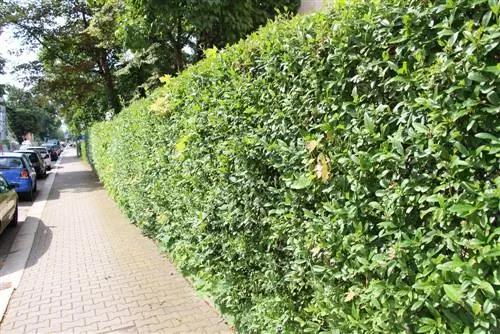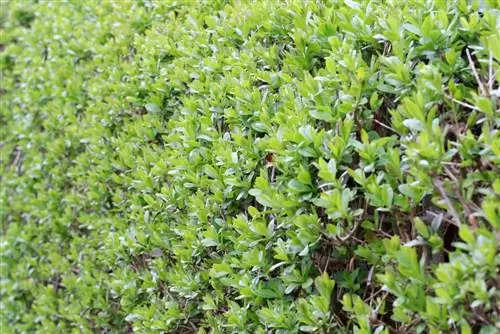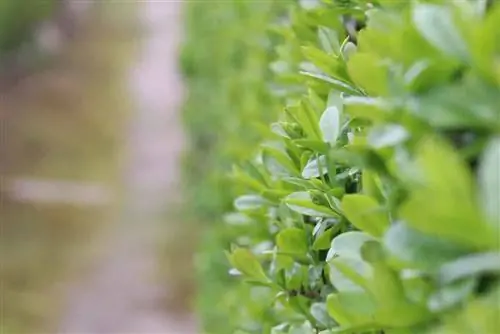- Author admin [email protected].
- Public 2023-12-17 03:39.
- Last modified 2025-06-01 06:48.
Privets are easy to care for and hardy, which is why many gardeners prefer to use them to border gardens. Diseases and pests rarely occur in plants belonging to the rain willow family. The perplexity is all the greater when the ornamental trees show leaf spots and changes in appearance. In order to take the right countermeasures, it is important to interpret the type of infestation or infection. If detected early, many diseases and pests can be eliminated without affecting the plants.
Avoid care errors
The small leaves and the inconspicuous, white flowers are characteristic of almost all 50 species of Ligustrum. The blue-green berries that appear in autumn serve as a tasty food source for birds and small mammals. Whether as a solitary plant or as an impressive privacy hedge: the ornamental trees, which mainly come from Asia, are undemanding. Only a few requirements have to be met for the universally applicable plants to thrive:
- Avoid dark locations
- Fertilize with compost in spring and late summer
- A liquid or long-term fertilizer is administered from March to the end of August
- The substrate must be permeable and deep
- A radical cut back into the old wood is tolerated
- Older plants survive longer dry periods without any problems
- Evergreen species also need to be watered in winter
A minimum level of care is necessary to promote the privet's resilience and growth. If the plant, which belongs to the rain willow family, is neglected, this is first noticeable visually in the condition of the leaves. In many cases, pale discoloration of the foliage is due to a problem with the nutrient supply. Privet is one of the weakly consuming plants. However, you should not completely avoid fertilizer. If the leaf discoloration is due to a lack of minerals, you should apply a liquid fertilizer immediately. Do not exceed the dose. Because when it comes to privet, the motto is: less is more.
The pale foliage color can also mean exactly the opposite and be an indication of over-fertilization. Stop fertilizing until the plant fully recovers. In addition to discoloration of the leaves, an excessive dose of nutrients can also be noticeable in the strong growth of the shoots. The branches hardly become woody and can take away light from the parts of the plant underneath. Remove the “water shoots” or shorten them significantly.
Prevent root rot
Privet has nothing against a slightly moist substrate. For evergreen species, you should also use a watering can in winter so that the root ball does not dry out completely. It is important to pay attention to the correct dosage. The ornamental trees are not aquatic or swamp plants; standing moisture can promote infestation with ascomycete fungi and cause root rot. The pathogens secrete a toxic substance that decomposes the underground parts of the plant from the inside out. This process is perceived on the surface in the form of a strong smell. The shoots and leaves hang limply and die.
There are no effective remedies against root rot, which many gardeners fear. Fungicides from specialist retailers do not provide any relief. Old and young plants are equally affected by the disease. You can only take preventative measures to protect the ornamental trees from infestation:
- Pour in smaller amounts, but more often
- Mulch the soil regularly
- Permanently loosen the soil with small pebbles
- When using privet in the pot, create drainage at the bottom of the container
- Remove excess irrigation and rainwater from planters
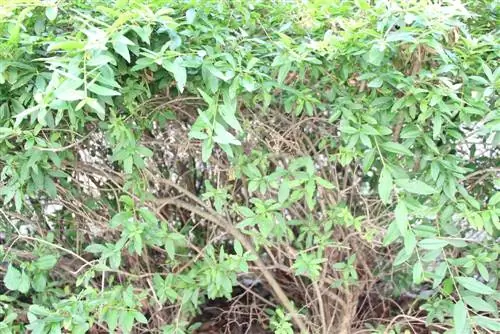
There is a trick you can try to save small plants from a root rot infection. Place the plants in dry substrate. If there are still enough intact roots, there is a good chance that the privet will recover from the disease. Do not cut back infected parts of the plant.
Leaf spots on privet
Fungal pathogens not only threaten the roots of plants. A lack of light and prolonged, humid weather can promote infestation with various types of fungi that attach themselves to the leaves of ornamental plants. The color of the spots varies and depends on the type of pathogen. From brown, black, to gray and yellow, everything is possible. The size of the noticeable moles varies between 2 - 6 mm, and the transition is usually smooth. An exact determination of the type of pathogen is only possible by examining the fruiting bodies under a microscope. However, the affected area can also provide a rough indication. For example, Cercospora ligustria prefers to colonize the top of the leaves, while the pathogen Thedgonia ligustrina is predominantly found on the underside of the leaves.
For passionate hobby gardeners, this plays a minor role. Before taking appropriate countermeasures, you should make sure that the leaf spots are not due to pests. Cell sap-sucking insects, such as aphids and spider mites, can cause similar symptoms on the plants when they feed.
- Check the underside of the leaves for the damaged animals
- An excessive population of ants on the plant indicates lice
- Sticky shoots can be caused by pest excretions
- Aphids often stay on the branches of young shoots
You should tackle the disease with a combination of different remedies. An infestation is not just an optical problem, but can also lead to the death of young and weakened plants. If left untreated, the fungal pathogens overwinter in the dead leaves and spread to other plants in the warm spring.
- Remove dead leaves and shoots with household waste
- Pour with diluted nettle decoction
- Avoid locations in full shade
- Do not water unnecessarily over the foliage of privet
- A windy place promotes resilience
- Apply commercial fungicides if necessary
Use gloves when working and disinfect all equipment used. How to reduce the risk of infection. A fungal infestation is persistent and treatment can take several months. If the disease returns annually, you may want to consider removing affected ornamentals entirely. As with disposing of dead leaves, do not throw the shrubs into the compost heap. There is a risk that the pathogens will spread through moisture and wind.
Patterns on the leaves
If your privet has misshapen leaves with strange, light green colored patterns, this could be due to viruses. Infection is rare and mainly affects weakened trees.
- Remove the infected leaves
- Cut back privet radically
- Replace the substrate generously
An exact determination of the viruses is not possible. In addition, there are no effective countermeasures. Support the resilience of your rainforests. If the disease cannot be contained, you should consider completely removing the affected plants. Then replace the soil with fresh substrate and avoid this location as a place for cultivating privet for the next 5 to 6 years. This will minimize the risk of the viruses remaining inactive in the soil and infecting the next rainforests.
Powdery mildew
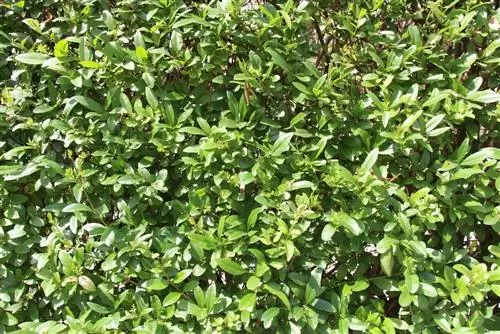
It's not just wetness that can affect privet plants. Dryness and heat promote the spread of powdery mildew. This fungus causes a flour-like coating on the leaves of the plants. Normally the disease is hardly noticeable and cannot even weaken young plants. With conventional home remedies and simple methods you can declare war on the pathogen:
- Dispose of the affected leaves
- Keep the substrate moist on hot summer days
- Spray a mixture of water and whey
Powdery mildew needs living plant tissue to thrive. You can therefore throw cut leaves and shoots into the compost without worry. You should only use chemical agents in exceptional cases.
Tip:
Nitrogen-containing fertilizers can promote powdery mildew infestation. Therefore, use different products when supplying nutrients.
Pests
Holes in the leaves or a silvery discoloration of the leaf veins is rarely due to a fungus orviral disease. The cause of these symptoms is more likely to be of animal origin. Damaging insects literally love to eat privet. Common examples include:
- Privet sawfly (Macrophya punctumalbum)
- Privet aphid (Myzus ligustri)
- Soft and blind bugs
- Bigmouth Weevil
Large and older plants can rarely be completely affected by the pests. It still makes sense to fight the six-legged pests. In this way, you reduce the risk of the insects also attacking other plants in the garden. You can get to grips with beetles etc. using the following methods:
- Collect larger animals by hand at dusk
- Water with nettle broth and increase the resistance of privet
- Set up special sticky traps
- Release animal predators, such as ladybirds and lacewing larvae
- Wipe affected shoots and leaves with a damp cloth soaked in vinegar
- Use nematodes
Privet in the pot should be separated from the rest of the plants. Do not dispose of wilted leaves and shoots with garden waste. Eggs and harmful insects can be found on the plant parts. Do not provide the pests with a source of food and encourage colonization with natural predators. The eggs for ladybirds, predatory bugs and other animal helpers can be found in well-stocked specialist shops or can be purchased directly online.
Use a combination of different methods. For example, strengthen the resistance of the plants through proper care and set up adhesive boards that are mixed with artificial pheromones and attract pests. Each of these traps works specifically against one type of insect. Make sure you put up the right boards.
Tip:
Use chemical agents against harmful insects only in emergencies. The products are aggressive and can also harm beneficial insects such as bees, butterflies and bumblebees.
Conclusion
Privet is one of the most famous hedge plants. In general, the plant is considered robust and resilient. However, the plant is not completely immune to diseases. In order to take the right countermeasures, the cause of the leaf discoloration or disturbing growth must first be found. Care errors often manifest themselves in the same way as fungal pathogens and diseases. The positive news: Viruses etc. can only rarely pose a threat to larger rainforests.

